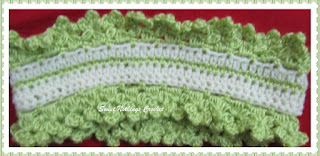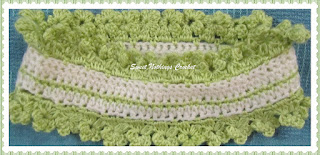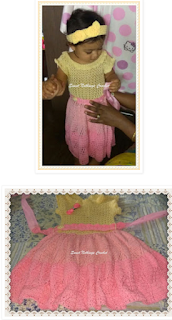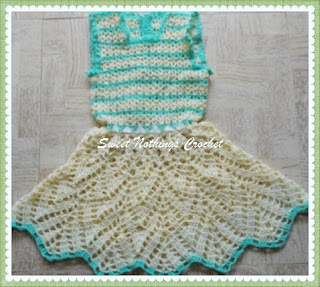ALL STARS SWEATER with a headband
This is a really simple project for a cute young
lady. I gave a whole set of ideas to the
mum and she wanted something ‘really simple’… and we settled on a version of
this sweater.
As I was given so much flexibility for this pattern, I went a little berserk ;)
Thank you for joining me.
In case you have just joined me, know that you can access all of my earlier creations by checking under ‘categories’ on the right hand side of this blog under “Labels”. Then, for your convenience, follow me here or on Facebook, You Tube, Pinterest, Twitter or Instagram.
Check out all my social media handles at the bottom of this blog
Oh, and may I add that the fastest way to find any of my blogs is via Pinterest.
All my blogs can be printed. Find the printer friendly (green) link at the bottom of this blog. You can also hit Control P (or Command P for Mac) on your keyboard, and the blog will go directly to the connected printer.
Remember that you only print if absolutely essential. Save paper – Save Our Earth.
Do remember to add my blog URL when you make and show off your creation.
Just copy the link on the search bar above - that's the blog URL.
To purchase this or similar yarn online, click here to buy your yarns online via Amazon. While you will still pay the same, I may get paid by Amazon as well.
This is a free blog - so do pay it forward for me. Cheers.
I have used a combination of two coloured yarns
for the yoke, and one idea was to continue the dual color combination to the
sleeves.. and then, just for kicks, I tried the ‘body pattern’ on the other
sleeve.. and also along the front placket.
This blog is chockablock many ideas .. Let your creativity flow!
Thanks for joining me once again as we work on
and discover this new pattern together.
Materials used : Today I’ve
used ~ 200 gms of the lovely Bella Baby Baby Marvel Soft Baby 4-ply (in pistachio green) & 100 gms
of Bella Baby Marvel Soft Baby 4-ply acrylic yarn (in off white) with a 3.5 mm crochet hook
Size made : For
a 5 yr old
Difficulty level
: Intermediate Skill level
Stitches used : Using U.S terminology
Double Crochet : dc : yo, insert hk into st ; yo (3 lps on hk);
[yo, draw through 2 lps] twice. One dc made.
Chainless start for Double Crochet : I dislike the ch-2 / ch – 3 start, and this is what I do to start my row of dc.
Invisible join : Here’s a quick tutorial on how to join using the embroidery needle and whipstitch to get an invisible join at https://youtu.be/a6XZQ6VzJFM
Here is a sizing chart for general neck sizing
Here is a sizing chart for general body sizing
Abbreviations used :
ch : Chain sp(s) : Space(s)
dc : Double crochet hk : Hook
st(s) : Stitch(es) sl-st : slip stitch
sk : Skip sp : space
rep : repeat
fsc : Foundation single crochet
Instructions
Please note that I start all my rows with a ch 1, turning chain for ease.
Please check the top of this blog for easy video tutorials on all stitches used in today's pattern.
Please read through all my notes before you pick up your hook, so you know just where we're heading in our pattern.
In my patterns I work with the principle of stitch count and body measurement. This means that you need to work the stitch count in pattern, till you get the measurement (length and/or width) that you need for your project.
So before we set off on our new creative
journey, let’s take a quick look at what we’re creating here today. We start at
the neckline and work our way down to the bottom of the sweater. The neckline is a raglan shaped presentation
and there is a ready reference chart for different sizes at the top of this
blog.
Once we have reached the armhole or the round
chest size of the child, we will continue straight down without increases.
I have decided to work my sweater in one piece,
starting at the centre front, working around the back and then coming back to
the front from the other side.
You could decide to divide at the armholes, and
then work two fronts and one back piece separately and then join them along the
sides as well.
The yoke portion is worked in all dc – but you could choose to work in hdc as
well. Remember though that the smaller
your stitch size (and yarn size), the more number of rows you’d need to reach
the armhole.
The original pattern for this is at
This is a free pattern, but the write up is not
in English. Here are my notes as I make this pattern. Please refer to the original link for the
pattern of the top. Thank you.
Part 1 : Yoke
1. I
started with fsc as per the chart given for necklines (at the top of this blog).
2. See
the number of stitches needed for the back/front and sides, and place markers
accordingly for the corner stitch
3. In
the corner stitch for the first row, I have worked (3 dc; ch 1, 3 dc) all in
that same st.
4. In
all following rows, I’ve worked the (to) in the ch-1 sp for the corners.
5. I’ve
decided to change colors every other row, and I’ve decided to use sc down the
row (instead of dc), so in the corners, I’ve opted to work in a
(3 sc ; ch
1, 3 sc) in the corner ch-1 sp.
6. I
suggest you work the raglan yoke pattern till you reach the armhole or till you
get the width needed for the chest (round measure), whichever is first.
7. You
will continue then without further increases for the pattern of the lower part
of the sweater.
Part 2 : Body of the sweater
This is one pattern I’ve not been able to
fathom. There is no chart, and the photo
tutorial eludes me. I am not sure what
that stitch is.. I figured that it’s worked in sc and we’re picking up 5 sts at
a time – but try as I may, I am not getting the same look as this pink project.
Ah well, time to create and get cracking.
I’ve decided to use the Star Stitch in my
project, working over 5 sts.
Before we plunge into the stitch, I’d like to
explain what a Star Stitch is.
1. The
Star Stitch is always worked only on the front of your work.
2. For
this beautiful stitch, we pick up a set of 5 loops and then work through all of
them. “Pick up a loop” means that you
will put your hook into the stitch indicated, yarn over and draw or pick up a
loop.
3. You
will have a set of 5 sts on your hook before you will yarn over and pass it
through all the stitches, to make one start stitch.
4. There
is an “eye” to this Star stitch. The
“eye” is the top point of the stitch, which serves as the 1st
“stitch” for the next and all following stitches.
5. For
your 2nd and all following stitches, you will put your hk into the
‘eye’ of the last star stitch and draw a lp, then pick up a lp in the last
st of the previous star stitch, and finally pick up lps in the next 2
sts. You will then complete this star
stitch by working a yarn over, and then passing through all the loops on your
hk.
So that’s the Star stitch that we’re using here.
There’s another thing that we need to do as
we start on the body of our sweater, and that’s to join the fronts and back
across the armhole. I have joined the two parts in the 1st row of
the body of the sweater.
Fold your work in half and (if needed mark the
corners that will be joined) work the first row such that you join the back and
front.
Our stitch count is multiples of 2.
Depending on how lacy or ‘holey’ you want your
project, work an sc (less holes) or a hdc in the following row.
Row 1 : (Wrong side
of work) : 2 hdc in the 1st st ;
(sk next st ; 2 hdc in the next st)
;
rep (to) till the last 2 sts ;
sk next st, 2 hdc in the last st. Turn.
In this
row, we will work our Star Stitch
Row 2 : (Right side
of work) :
[yo, insert hk in the 1st st ; yo,
insert hk in the next st ;
yo and pass through the 5 lps on hk] ;
ch 1 (creates the “eye” of the Star St) ;
* {insert hk in the “eye” just made and draw a
lp ;
insert hk in the last lp of the previous Star st just made and draw a lp ;
insert hk in the next 2 sts and draw up 2 lps ; yo and pass through the 5 lps
on hk} ;
ch 1 (creates the “eye” of the Star St) * ;
rep *to* till the end. Turn.
In the
following row, we will work only in the “eyes” of the Star St.
The last st that you’ve worked in the
previous row was the ch 1, that forms the eye, and this will be the 1st
eye you will work in.
Yet again, depending on how lacy or ‘holey’ you
want your project, (or depending on what stitch you used in Row 1, work a sc or
a hdc in the following row.
Row 3 : (Wrong side
of work) : 2 hdc in the 1st “eye”
and in each “eye” till end. Turn.
And though this seems totally unbelievable,
we’ve just finished one pattern repeat.
Please put your work down and admire the beauty you’ve created.
Rep Rows 2 & 3 till your pattern reaches the
length needed.
If you are planning on working a button placket
and/or a base border, please ensure to work the length accordingly to keep
space to get that border in.
Part 3 : Sleeves
So initially, I used two colors for my yoke ..the idea being to carry that color combination
down the arm. The yoke has been done
with just hdc all around, so for the sleeves too, I’d suggest you keep it with hdc
all around.
And then I thought that I'd use the body pattern on the sleeves - and this is what I've eventually gone with. So you now have two ideas for your sleeves.
To
start pick up
where you’ve left off at the armhole and work a round of hdc in each st all
around. Continue with hdc in each st all
around for every round till you are about 1” from the sleeve length needed. If you want a wider sleeve cuff, then you
will work that many inches short for the sleeve – i.e if you need a
sleeve length of 15” and are going to work in a 2” border, you will work in hdc
till you have a sleeve length of 13” and then work this border in for the last
2”.
The other idea is to work the body Star Stitch pattern
down the arm. For this once again, I’d
suggest we start with a round of hdc all around, and join with a sl-st at the
end. The Star Stitch must only be worked
along the front / right side of work, which suits us perfectly as we will be
working in rounds. Remember that yet
again, you will work the 2 hdc only in the eyes of the Star stitch, which will
be simpler to “find” as you’re working on the right side of your work.
Border
:
Round
1 : sc in the 1st hdc and in each hdc
till the end. Join with a sl-st to the 1st
st.
For our border, we’ll be working with the Camel
stitch.
The Camel stitch is a variation of the Single
crochet back loop stitch. The only
difference is that you work the stitch in the loop after the back loop –
which is called the ‘third loop’.
In case you find the Camel stitch too hard, may
I suggest you work the sc in back loops only (sc-blo) and that will give a
really lovely ribbed effect as well.
How to do the Camel stitch :
The camel stitch is a lot like the back loop stitch, but you get a knitted
finish on the top of your work. Check
out this video to see how to get this done. https://www.youtube.com/watch?v=wmJorQch4D0
Round
2 : Camel stitch in the 1st sc and in
each sc all around.
Rep Round
2 till you have the border / cuff length needed.
Before you
fasten off, please check that your sleeve length is correct, and then fasten
off and weave in ends.
Repeat for the 2nd sleeve as well.
Part 4 : Front placket and border for sweater
I have
decided to work one continuous border for my sweater, which will start at the
front placket, go around the back of the neck, come back around the front of
the sweater for the other placket, and then go around the bottom of the sweater
to join back at where I started.
So there
are ideas here :
1.
You could yet again try to work the Star
Stitch as a front panel, and then work a smaller border wherein you can work
the button holes ; OR
2.
You can
work the Camel stitch all around. The
beauty of the Camel stitch can only be seen when worked on the front or right
side of the garment, and it can therefore only be worked in a round. This suits us perfectly when working it the
way I’ve planned ; OR
3.
You can
work both the Star Stitch and the Camel stitch as borders.
That said,
yet again, if you decide to work the sc-blo, here’s your chance to be different
and unique.
As we’ve
just worked the Camel stitch around the sleeve cuff, you know what we need to
do.
You will start with a round of sc all around from the
front, around the back, down the other front and then around the lower part of
your sweater. Remember that at
each corner, you will need to work in 2 or 3 sc in the same st to get a neat
turn. I say 2 or 3 as this depends on
the thickness of your yarn – the thicker the yarn, the more bukly that turning
will be, so 2 sts should suffice.
However, you will need to see what looks neat and flat and work
it accordingly.
Your Round 1 will be the 1st round of Camel
stitch all around and you will join with a sl-st at the last st.
I suggest
that you work as many rounds here as you did for the cuff, just to get a uniform
look.
If you are
planning on this being a button-down sweater, you will need to add in a set of
button holes along one side of your front placket. For adding a button hole all I’ve done is work 2 ch
(or as many ch needed depending on the size of your button as well as the
thickness of your yarn) and sk the next 2 sts.
Space your holes by working the Camel st in between 2 sets of
skipped stitches (that will determine the distance between two buttons).
In the next round, you will work a Camel st or sc-blo in
the ch-2 sp. The difference in working
the sc in this space is that usually one works the st directly into the
space, but in this case, I’ll suggest that you work your stitch into the chains you’ve made and not
into the ch-sp.
In the next round, you will work a Camel st in each st
all around.
Rep the
last round till you have a border / placket of the size needed. Remember that it looks really neat if you
have your button holes in the middle of the placket, so do decide the width you
want before you start this exercise.
Part 5 : Make your own button
I should
also share a new idea I had for the button. I had these lovely little pink
beads that I’d already used on that final row, and thought they’d look lovely
as a button. So first I took a regular shirt /pant button and covered it with a
little fabric. I then sewed in the beads
onto that little fabric top. The base of
the button was easy to attach on, as there is the fabric to hold on to.. and I
think the end result is pretty amazing.. what do you think?
For more
information and photos, visit
Part 6 : Headband
The
original pattern has this lovely flower-like pattern that is around the chest
of the sweater. I thought I’d rework
that pattern as a headband, so here’s what I’ve come up with.
The stitch
count is multiples of 4.
We will
work the headband in one continuous round.
We will therefore start with a fsc chain, and then ensuring that there
is no twist in the chain, join it to the start fsc to create a round. This round will go around the head, so check
that this is the right size needed for the child you are making this for. Check the top of this blog for a ready chart
on general head sizes.
If working
in two colours, you could choose one colour for the hdc rounds and one for the
floral portion. As you could be working
it all in one colour, I am not going to specify where you could change
colours. Go ahead and create.
Oh and as
usual, there are options .. so do read through to the end before you decide on
the pattern you want to use.
Finally,
this floral pattern is worked in one continuous movement and it is a little bit complicated. The link for the original pattern has a photo
tutorial, which may help – so please take a look at that if needed.
Start with a fsc chain in
multiples of 4 and join with a sl-st to the 1st st.
Round
1 : hdc in the 1st fsc and in each fsc till end.
Join with a sl-st to the 1st st.
Round
2 : hdc in the 1st hdc and in each hdc till end.
Join with a sl-st to the 1st st.
In the
following round, depending on how loose (or low) you want your flowers to hang,
you can choose to make a ch 3 or a ch 4 sp.
This also depends on how thick or thin a yarn you’re using.
Round
3 : sc in the 1st hdc ; (ch 3, sk next 2 hdc, sc
in the next hdc) ; rep (to) all around and join with a sl-st to the 1st
st.
In the
following last round, we will form our petals for the flowers.
We will
use our dc 2-tog and dc 3-tog in this round.
Check the top of this blog for a “how to”.
Before we
work on the flower, let’s understand how we will work this continuous round for
the flowers.
We will first work a dc 3-tog and then on the top of this dc 3-tog we
will work the next set of stitches. The top
of this dc 3-tog therefore will become the centre of the flower. Each petal
is made up of [ch 2, dc 2-tog , ch 2], which is worked as one set and we will
sl-st onto the top of the dc 3-tog. We
will work 2 sets of [to] to make 3 petals, and the 4th petal will be
a dc 3-tog.
Easy
enough, right?
Round
3 : sl-st into the 1st ch-3 sp ; dc 3-tog in the
same ch-3 sp ;
*[ch 2, dc
2-tog , ch 2] and sl-st onto the top of the dc 3-tog (which will now form the
centre of our flower) ;
rep [to] 2
times, and sl-st onto the top same dc 3-tog (which is the centre of the
flower) ;
dc 3-tog
in the same dc 3-tog and sc in the next ch-3 sp ; ch 3, sc in the next ch-3 sp ; dc 3-tog in
the same sc (which you’ve just made in the next ch-3 sp)* ; rep *to* all
around till end and join with a sl-st to the 1st st.
This
completes the flowers on one side of our headband.
The
pattern written here is as per the pattern I *think* is on the blog. I have, however, decided to work a flower in
each ch-3 sp.. so just working a dc 3-tog in the same ch-3 sp where you work
your sc has worked for me.. and then ofcourse the [to] for the flower petals
and this is what I’ve done.
I’ve
decided to work the flowers on the other side as well. For this, I’ve re-attached my yarn at the 1st
st on the other side of the headband, and worked only Round 3 (the flowers
round), along that end as well.
Fasten off and weave in all ends.
Ta da..
your absolutely stunning headband is ready.
And just
to trouble you (?) and give you another idea.. you could work this as one flat
piece for a belt as well. Work the same
pattern, just don’t join the two ends.. and maybe attach a satin ribbon at each
end.. and voila! You have a beautiful belt to match your headband.
Enjoyed this ?? I sure did.. come back right
here for more freebie patterns
If you're visiting me here for the first time, and have liked the experience, do add me to your mailing list (for your convenience) , and all my future free patterns will come straight to your mail box.
I’d appreciate if you could credit my blog (and link the original pattern link) when you make your own creation. Thanks.
Have a great day and see you soon.
I have a few girls dresses already made, and just
in case you want a dekho at those free patterns … here you go

























































No comments:
Post a Comment
Thanks for taking the time to stop by. Do tell me what you think. Cheers